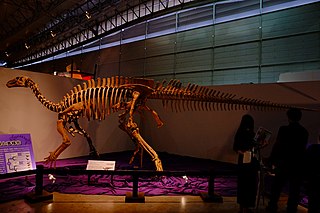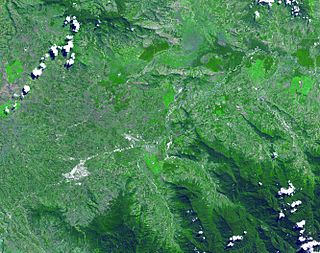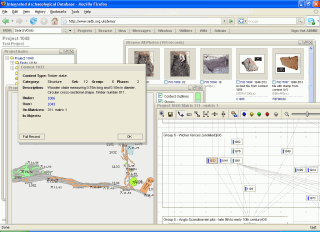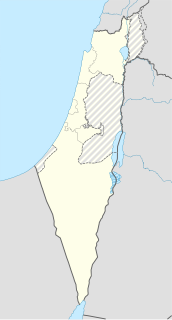Related Research Articles

Pal(a)eoethnobotany or archaeobotany is a sub-field of environmental archaeology that studies plant remains from archaeological sites. Basing on the recovery and identification of plant remains and the ecological and cultural information available for modern plants, the major research themes are the use of wild plants, the origins of agriculture and domestication, and the co-evolution of human-plant interactions. Archaeobotany is arguably now a mature discipline, but one that is facing challenges relating to data and communication.

Phytoliths are rigid, microscopic structures made of silica, found in some plant tissues and persisting after the decay of the plant. These plants take up silica from the soil, whereupon it is deposited within different intracellular and extracellular structures of the plant. Phytoliths come in varying shapes and sizes. Although some use "phytolith" to refer to all mineral secretions by plants, it more commonly refers to siliceous plant remains. In contrast, mineralized calcium secretions in cacti are composed of calcium oxalates.

Equijubus, is a genus of herbivorous hadrosauroid dinosaur from the Early Cretaceous of northwestern China.
Cactus Hill is an archaeological site in southeastern Virginia, United States, located on sand dunes above the Nottoway River about 45 miles south of Richmond. The site receives its name from the prickly pear cacti that can be found growing abundantly on-site in the sandy soil. Cactus Hill may be one of the oldest archaeological sites in the Americas. If proven to have been inhabited 16,000 to 20,000 years ago, it would provide supporting evidence for pre-Clovis occupation of the Americas. The site has yielded multiple levels of prehistoric inhabitance with two discrete levels of early Paleoindian activity.

Kuk Swamp is an archaeological site in New Guinea, that lies in the Wahgi Valley of the highlands. The swamp developed in a former lake basin, as it was filled by an alluvial fan or deposits of water-transported material. Archaeological evidence for early agricultural drainage systems was found here, beginning about 9,000 years ago. It includes draining ditches of three major classes, which were used to convert the area to an anthropogenic grassland. The native crop taro was grown here.
Post-excavation analysis constitutes processes that are used to study archaeological materials after an excavation is completed. Since the advent of "New Archaeology" in the 1960s, the use of scientific techniques in archaeology has grown in importance. This trend is directly reflected in the increasing application of the scientific method to post-excavation analysis. The first step in post-excavation analysis should be to determine what one is trying to find out and what techniques can be used to provide answers. Techniques chosen will ultimately depend on what type of artifact(s) one wishes to study. This article outlines processes for analyzing different artifact classes and describes popular techniques used to analyze each class of artifact. Keep in mind that archaeologists frequently alter or add techniques in the process of analysis as observations can alter original research questions.
Contemporary archaeology is a field of archaeological research that focuses on the most recent past, and also increasingly explores the application of archaeological thinking to the contemporary world. It has also been referred to as the archaeology of the 'contemporary past'. The use of this term in the United Kingdom is particularly associated with the Contemporary and Historical Archaeology in Theory (CHAT) conference group. The field forms part of historical archaeology, or the archaeology of the modern period. Unlike ethnoarchaeology, contemporary archaeology studies the recent and contemporary past in its own right, rather than to develop models that can inform the study of the more distant past.
Deborah M. Pearsall is an American archaeologist who specializes in paleoethnobotany. She maintains an online phytolith database. She is a full professor in the Department of Anthropology at the University of Missouri in Columbia, Missouri, where she first began working in 1978. She received her Ph.D. in anthropology from the University of Illinois at Urbana-Champaign in 1979, with a dissertation entitled The Application of Ethnobotanical Techniques to the Problem of Subsistence in the Ecuadorian Formative.

Domuztepe was a large, late Neolithic settlement in south east Turkey, occupied at least as early as c.6,200BC and abandoned c.5,450BC. The site is located to the south of Kahramanmaraş. Covering 20 hectares, it is primarily a Halaf site of the 6th millennium BC and is the largest known settlement of that date.
ACS Chemical Neuroscience is a peer-reviewed scientific journal published by the American Chemical Society. It covers research on the molecular underpinnings of nerve function in organisms and animal models. The journal was established in January 2010. The journal is one of the first journals of the American Chemical Society to be available in online-only format. The founding editor-in-chief is Craig W. Lindsley.
Dolores Piperno is an American archaeologist specializing in archaeobotany. She is a senior scientist emeritus of the Smithsonian Tropical Research Institute in Balboa, Panama and the Smithsonian National Museum of Natural History, Washington.
Jan F. Simek is an American archaeologist and educator who was the interim president of the University of Tennessee system from 2009–2010.

Paleofeces are ancient human feces, often found as part of archaeological excavations or surveys. The term coprolite is often used interchangeably, although coprolite can also refer to fossilized animal feces. Intact feces of ancient people may be found in caves in arid climates and in other locations with suitable preservation conditions. They are studied to determine the diet and health of the people who produced them through the analysis of seeds, small bones, and parasite eggs found inside. The feces can contain information about the person excreting the material as well as information about the material itself. They can also be chemically analyzed for more in-depth information on the individual who excreted them, using lipid analysis and ancient DNA analysis. The success rate of usable DNA extraction is relatively high in paleofeces, making it more reliable than skeletal DNA retrieval.

The Integrated Archaeological Database system, or IADB for short, is an open-source web-based application designed to address the data management requirements throughout the lifespan of archaeological excavation projects, from initial excavation recording, through post-excavation analysis and research to eventual dissemination and archiving.

Hatula is an early Neolithic archeological site in the Judean hills south of Latrun, beside Nahal Nachshon, in Israel, 20 kilometres (12 mi) west of Jerusalem. The site is 15 metres (49 ft) above the riverbed on a rocky slope in an alluvial valley. Excavations revealed three levels of occupation in the Natufian, Khiamian and PPNA (Sultanian).

On the Swahili Coast in southern Tanzania lie the ruins of a stone town known as Songo Mnara. The stone town was occupied from the 14th to 16th centuries. Songo Mnara has been recognized as a UNESCO World Heritage Site, along with nearby stone town Kilwa Kisiwani. In total, archaeologists have found six mosques, four cemeteries, and two dozen house blocks along with three enclosed open spaces on the island. Songo Mnara was constructed from rough-coral and mortar. This stonetown was built as one of many trade towns on the Indian Ocean.
The Fosters Site, designated 20SA74, is an archaeological site located near Bridgeport, Michigan. It was listed on the National Register of Historic Places in 1982.
Lisa-Marie Shillito is a British archaeologist and senior lecturer in landscape archaeology as well as director of the Wolfson Archaeology Laboratory and Earthslides at Newcastle University. Her practical work focuses on using soil micromorphology, phytolith analysis and geochemistry in order to understand human behaviour and landscape change. Her work includes the Neolithic settlements of Çatalhöyük in Turkey and Ness of Brodgar and Durrington Walls in Britain, but also Crusader castles and medieval settlements in Poland and the Baltic and in the Near East.
Alison Weisskopf (1960–2018) was a British archaeologist specialising in archaeobotany, specifically the analysis of ancient phytoliths.
Lynley A. Wallis is an Australian archaeologist and Associate Professor at Griffith University. She is a specialist in palaeoenvironmental reconstruction through the analysis of phytoliths.
References
| | This biographical article about an archaeologist is a stub. You can help Wikipedia by expanding it. |